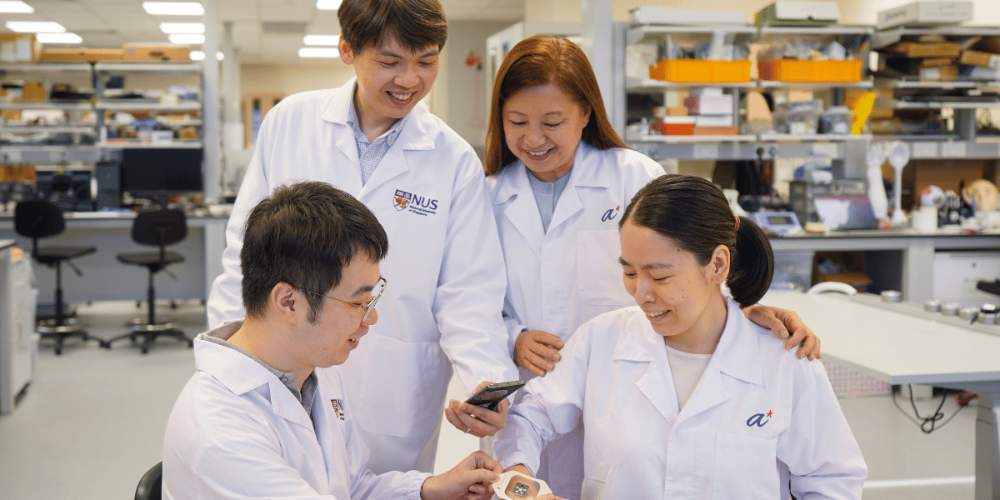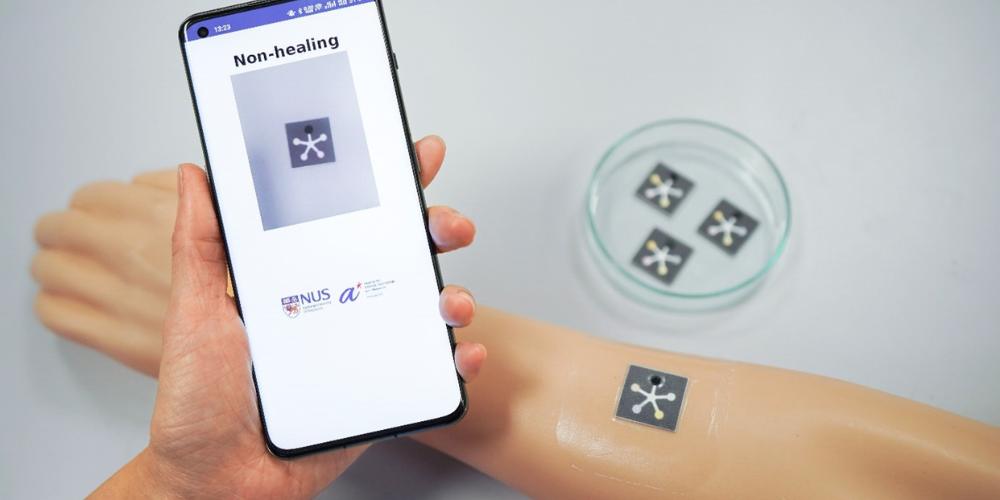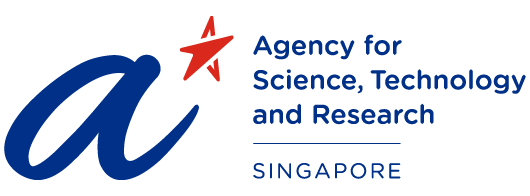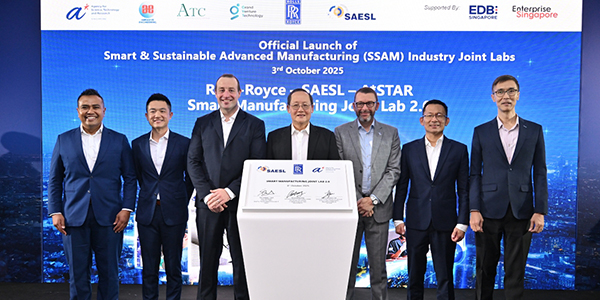A*STAR NEWS
Innovative Paper-like, Battery-free, AI-enabled Sensor For Holistic Wound Monitoring
Low-cost and versatile patch can be customised for different types and sizes of wounds, and provides early warning of adverse conditions to facilitate wound care and management
Singapore - Timely and effective monitoring of wound healing status is critical to wound care and management. Impaired wound healing, such as chronic wounds (i.e. those that do not heal after 3 months) and post-burn pathological scars, could result in life-threatening medical complications and considerable economic burden to patients and healthcare systems worldwide.
A recent invention by a team of researchers from the National University of Singapore (NUS) and A*STAR’s Institute of Materials Research and Engineering (IMRE), provides a simple, convenient and effective way of monitoring wound recovery so that clinical intervention can be triggered in a timely manner to improve wound care and management.
 The PETAL sensor patch technology invented by a team of scientists led by Associate Professor Benjamin Tee (standing, left) from the National University of Singapore (NUS) and Dr Su Xiaodi (standing, right) from A*STAR’s Institute of Materials Research and Engineering (IMRE) provides a simple, convenient and effective way of monitoring wound healing. With them are team members Mr Yang Zijie (seated, left) from NUS and Dr Zheng Xinting (seated, right) from IMRE.(Credit: National University of Singapore)
The PETAL sensor patch technology invented by a team of scientists led by Associate Professor Benjamin Tee (standing, left) from the National University of Singapore (NUS) and Dr Su Xiaodi (standing, right) from A*STAR’s Institute of Materials Research and Engineering (IMRE) provides a simple, convenient and effective way of monitoring wound healing. With them are team members Mr Yang Zijie (seated, left) from NUS and Dr Zheng Xinting (seated, right) from IMRE.(Credit: National University of Singapore)
Currently, wound healing is typically examined visually by a clinician. Wound infections are mostly diagnosed via swabbing followed by a bacteria culture which involves long waiting time and does not provide timely wound diagnosis. This makes accurate prediction of wound healing challenging in the clinical setting. In addition, wound assessment typically requires frequent manual removal of dressing, which elevates the risks of infection and may cause additional pain and trauma for patients.
“To address this challenge, NUS researchers combined our expertise in flexible electronics, artificial intelligence (AI) and sensor data processing with nanosensor capabilities of IMRE researchers to develop an innovative solution that could benefit patients with complex wound conditions,” said Associate Professor Benjamin Tee from the Department of Materials Science and Engineering under the NUS College of Design and Engineering, and the NUS Institute for Health Innovation & Technology.
The PETAL (Paper-like Battery-free In situ AI-enabled MuItiplexed) sensor patch comprises of 5 colorimetric sensors that can determine the patient’s wound healing status within 15 minutes by measuring a combination of biomarkers – temperature, pH, trimethylamine, uric acid and moisture of the wound. These biomarkers were carefully selected to effectively assess wound inflammation, infection as well as the condition of the wound environment.
"We designed the paper-like PETAL sensor patch to be thin, flexible and biocompatible, allowing it to be easily and safely integrated with wound dressing for the detection of biomarkers. We can thus potentially use this convenient sensor patch for prompt, low-cost wound care management at hospitals or even in non-specialist healthcare settings such as homes,” explained Dr Su Xiaodi, Principal Scientist, Soft Materials Department, A*STAR’s IMRE.
The sensor patch is able to operate without an energy source – sensor images are captured by a mobile phone and analysed by AI algorithms to determine the patient’s healing status.
Assoc Prof Tee said, “Our AI algorithm is capable of rapidly processing data from a digital image of the sensor patch for very accurate classification of healing status. This can be done without removing the sensor from the wound. In this way, doctors and patients can monitor wounds more regularly with little interruption to wound healing. Timely medical intervention can then be administered appropriately to prevent adverse complications and scarring.”
The design and fabrication of the PETAL sensor patch was reported in the scientific journal Science Advances on 16 June 2023.
Battery-free sensor analyses five wound biomarkers in a single patch
 The PETAL sensor patch comprises 5 colorimetric sensors that can determine the patient’s wound healing status within 15 minutes by measuring a combination of biomarkers – temperature, pH, trimethylamine, uric acid and moisture of the wound. A proprietary AI algorithm quickly analyses the digital image of the sensor patch to ascertain wound healing status with 97% accuracy.
(Credit: National University of Singapore)
The PETAL sensor patch comprises 5 colorimetric sensors that can determine the patient’s wound healing status within 15 minutes by measuring a combination of biomarkers – temperature, pH, trimethylamine, uric acid and moisture of the wound. A proprietary AI algorithm quickly analyses the digital image of the sensor patch to ascertain wound healing status with 97% accuracy.
(Credit: National University of Singapore)
Most wearable wound sensors measure only one or a small number of parameters, and they require bulky printed circuit boards and batteries. The PETAL sensor patch, on the other hand, currently measures 5 biomarkers and does not require any battery to operate. More biomarkers can be added if required.
Each PETAL sensor patch consists of a fluidic panel patterned in the form of a five-petal pinwheel flower, with each ‘petal’ acting as a sensing region. An opening in the centre of the fluidic panel collects fluid from wound and distributes the fluid evenly via 5 sampling channels to the sensing regions for analysis. Each sensing region uses a different colour-changing chemical to detect and measure the respective wound indicators – namely temperature, pH, trimethylamine, uric acid and moisture.
The fluidic panel is sandwiched between 2 thin films. The top transparent silicone layer allows for normal skin functions of oxygen and moisture exchange, and it also enables image display for accurate image capture and analysis. The bottom wound contact layer gently attaches the sensor patch to the skin and protects the wound bed from direct contact with the sensor panel, to minimise wound tissue disruptions.
After sufficient wound fluid is accumulated (usually within a few hours or over a few days), the PETAL sensor patch will complete the detection of biomarkers within 15 minutes. Images or a video of the sensor patch can be recorded on a mobile phone for classification using the proprietary AI algorithm.
In lab experiments, the PETAL sensor patch demonstrated a high accuracy of 97 per cent in differentiating healing and non-healing chronic and burn wounds.
Wound-friendly and versatile
There are no apparent signs of adverse reactions observed on the skin surface in contact with the PETAL sensor patch over four days, demonstrating the biocompatibility of the PETAL sensor patch for ambulatory wound monitoring.
In the current study, the performance of the PETAL sensor patch was demonstrated on chronic wounds and burn wounds. This AI-enabled technology can be adapted and customised for other wound types, by incorporating different colorimetric sensors, such as glucose, lactate or Interleukin-6 for diabetic ulcers. The number of detection zones can also be easily reconfigured to detect different biomarkers concurrently, so its application can be broadened for different wound types.
Next steps
An international patent for this invention has been filed and the researchers plan to advance to human clinical trials next.
The development of the PETAL sensor patch was conducted in collaboration with Professor David Becker’s research team from the Nanyang Technological University and the Skin Research Institute Singapore.
About the Agency for Science, Technology and Research (A*STAR)
The Agency for Science, Technology and Research (A*STAR) is Singapore's lead public sector R&D agency. Through open innovation, we collaborate with our partners in both the public and private sectors to benefit the economy and society. As a Science and Technology Organisation, A*STAR bridges the gap between academia and industry. Our research creates economic growth and jobs for Singapore, and enhances lives by improving societal outcomes in healthcare, urban living, and sustainability. A*STAR plays a key role in nurturing scientific talent and leaders for the wider research community and industry. A*STAR’s R&D activities span biomedical sciences to physical sciences and engineering, with research entities primarily located in Biopolis and Fusionopolis.
About National University of Singapore (NUS)
The National University of Singapore (NUS) is Singapore’s flagship university, which offers a global approach to education, research and entrepreneurship, with a focus on Asian perspectives and expertise. We have 16 colleges, faculties and schools across three campuses in Singapore, with more than 40,000 students from 100 countries enriching our vibrant and diverse campus community. We have also established our NUS Overseas Colleges programme in more than 15 cities around the world.
Our multidisciplinary and real-world approach to education, research and entrepreneurship enables us to work closely with industry, governments and academia to address crucial and complex issues relevant to Asia and the world. Researchers in our faculties, research centres of excellence, corporate labs and more than 30 university-level research institutes focus on themes that include energy; environmental and urban sustainability; treatment and prevention of diseases; active ageing; advanced materials; risk management and resilience of financial systems; Asian studies; and Smart Nation capabilities such as artificial intelligence, data science, operations research and cybersecurity.
Was This Article Helpful ?
A*STAR celebrates International Women's Day

From groundbreaking discoveries to cutting-edge research, our researchers are empowering the next generation of female science, technology, engineering and mathematics (STEM) leaders.
Get inspired by our #WomeninSTEM




